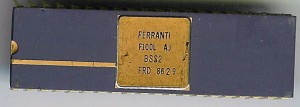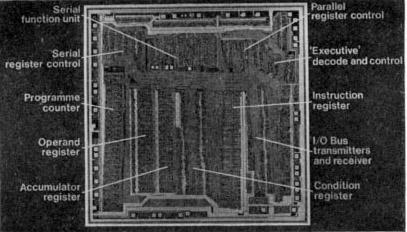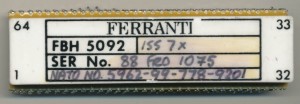CPU of the Day: Ferranti FBH 5092 – The F100L MCM
In the 1970’s the British electronics company Ferranti was commissioned by the Ministry of Defense to develop a processor for military applications. The desire was for something along the lines of the American MIL-STD-1750A processor.
In 1977 Ferranti released the F100-L 16-bit processor. It was made using Bipolar technology (rather then MOS) so it could easily hit speeds of 8MHz (albeit getting rather warm in the process). The F100-L was one of the first 16-bit processors made (along with the National Semiconductor PACE). The processor contained over 1500 gates and was made using collector diffusion isolation (an enhanced Bipolar design) and was produced with 3.5 micron features. The die itself occupied 60mm^2.
The F100-L was designed to handle real time data quickly and efficiently (time critical processing of signals and information is always one of the key requirements of a military specific design). It however was not as adaptable or flexible for use in standard computing environments. Ferranti tried to sell it commercially with only limited success. It ended up in some of the same uses as the Signetics/SMS 8X300 series of processors.
Ferranti also made the F100-L in a Hybrid, or MCM (Multi-Chip-Module) that contained a F100-L processor, a F101-L Multiply/Divide unit (a simple FPU), clock generators, and a pair of F112-L Data Interfaces to act as buffers. All of ths was packaged in a single 64 pin DIP.





October 2nd, 2012 at 2:27 am
I worked at Ferranti in the mid 70s, and I did my final year college project using the F100L. It was used in a quite a number of Ferranti’s own products in the Naval Systems Division (at that time, Ferranti’s CPU architecture choices were the F100L, or the non-integrated FM1600). I don’t think it had much (any?) success outside Ferranti itself. A bit too late, and of course far too expensive for the non-defence market.
I was told that that the F100 was used in a Guildford University space project (a real satellite, although built & run by amateurs). They had to use the F100 as part of the deal whereby Ferranti gave sponsorship. Well, the F100 was far too power hungry and complex to actually COMPUTE anything, so it was ‘used’ for thermal management. Meaning, it was put in series with a thermostat, and if it got too cold, the thermostat kicked in and the F100 dissipated a bit of power. I don’t think it even had a memory attached to it.
October 5th, 2012 at 12:42 am
Thanks for the further info. I just got in some other bipolar processors, the Fairchild F9450, again an attempt to use a military design (in this case MIL-STD-1750A, for commercial work. It was not a great success. To deal with the heat they used Beryllium Oxide for the case rather then the more normal alumina
October 5th, 2012 at 1:17 am
[…] done in CMOS, Bipolar, SoS, GaAs or even ECL. It was designed (like the Signetics 8X300 and the Ferranti F100) with real time processing in mind, similar to what we would call a DSP today.Many companies made […]
June 2nd, 2015 at 4:24 am
I graduated in Computer Science at City University (London UK) in 1977.
A 1976 graduate had written an F100L simulator to run on PDP-11.
My project was to “make it useful” by implementing a user interface and also instrumenting it to measure, for example, how many times each type of instruction was executed – the results could then be used to focus where optimisation would be most beneficial.
I do not know whether any of this work ever left the university. I had no contact with anyone from Ferranti.
March 2nd, 2016 at 11:37 am
I wrote a DOS for the F100L when I worked for Ferranti in about 1978. Used dual 8-inch floppies, and had to overlay some of the commands because there was not enough space in the max 32k word memory.